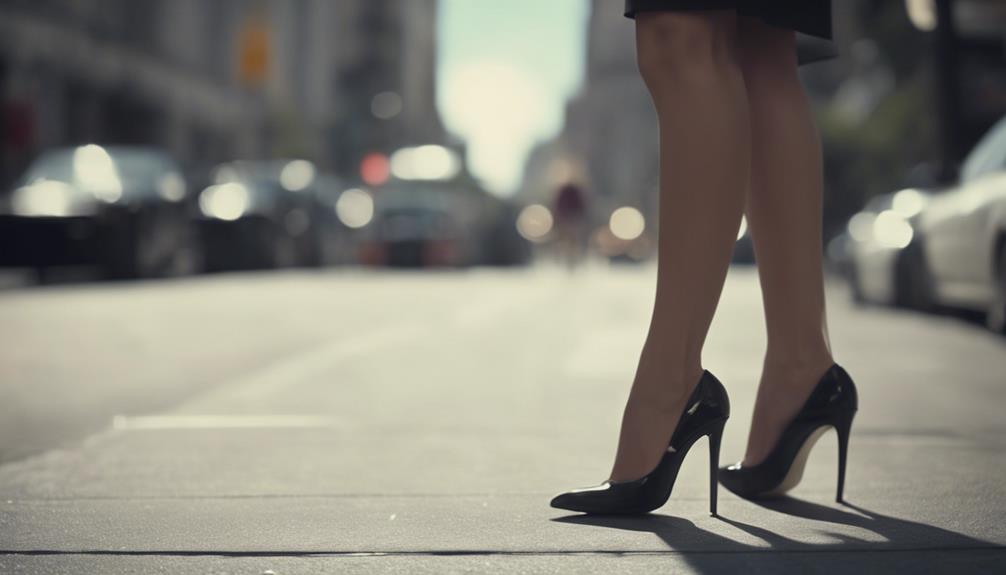Walking in high heels, I've unraveled the allure of these shoes – a mix of femininity, power, and societal norms. From their practical origins in the 16th century to symbolizing social status, high heels convey authority and confidence. Critics link them to gender stereotypes and beauty ideals, but they remain a form of identity expression. Feminist perspectives question their role in reinforcing patriarchal norms. The psychological impact on wearers is complex, affecting body image and interactions. Today, high heels are evolving, balancing tradition with comfort. Their mystique reveals a world of symbolism waiting to be uncovered.
Historical Evolution of High Heels

High heels, originally designed for practicality in the 16th century, have since evolved into a symbol of fashion and status through centuries of historical evolution. Initially worn by men for equestrian purposes, high heels gradually shifted to become a coveted fashion statement among European aristocrats in the 17th century. The height of the heel became synonymous with social standing, illustrating the intertwined relationship between footwear and societal hierarchy.
As high heels made their way into women's fashion in the 20th century, they became more than just a style choice. They symbolized a complex interplay of women's rights, societal pressure, and the feminine role. While some view high heels as a tool of oppression, enforcing outdated gender norms and physical discomfort, others argue that the choice to wear high heels can be empowering, allowing women to embrace their femininity on their own terms.
The history of high heels reveals a nuanced narrative of how footwear can reflect and shape cultural attitudes towards gender. As women continue to navigate the intersection of fashion, identity, and societal expectations, high heels remain a poignant symbol of the ongoing dialogue surrounding women's rights and the fluidity of feminine expression.
Symbolism and Power Dynamics
High heels have long been emblematic of power and femininity, carrying with them notions of authority and confidence. The elevated stature they provide can subtly shift social and professional dynamics, influencing perceptions of dominance and control.
However, the expectation for women to wear high heels can also highlight gender norms and the complex interplay between fashion, identity, and societal expectations.
Symbolic Gender Expression
Symbolizing authority and dominance in various cultures, high heels have historically been associated with power and status. However, when it comes to symbolic gender expression, they take on a whole new meaning.
For many individuals, high heels represent more than just physical elevation; they embody the essence of femininity and self-expression. By wearing high heels, individuals can tap into a sense of power and confidence traditionally associated with femininity. These shoes serve as a tool for expressing one's gender identity and personality through fashion, challenging and reshaping societal norms.
The symbolic power of high heels in gender expression transcends mere aesthetics, influencing how individuals perceive themselves and are perceived by others.
High Heels and Authority
From the battlefields of the Persian Empire to the courts of European elites, the elevated stature of high heels has long been intertwined with notions of authority and power. High heels symbolize more than just fashion; they represent a historical trajectory of power dynamics.
The association between high heels and authority dates back centuries, emphasizing dominance and control. Worn by cavalry soldiers for stability in battle and later by aristocrats to showcase wealth, high heels have been a symbol of social status and privilege.
Even in modern times, the symbolism of high heels continues to convey power and influence. By wearing high heels, individuals can command respect, exude authority, and project confidence in various professional settings. The allure of high heels lies not only in their aesthetic appeal but also in the power they symbolize.
Societal Perceptions and Criticisms

In the world of fashion and societal norms, opinions on high heels vary widely, sparking debates about gender roles and self-expression. High heels have long been associated with the feminine mystique, symbolizing traditional beauty standards and power for women. However, critics argue that high heels perpetuate gender stereotypes by prioritizing appearance over comfort and practicality, raising questions about bodily autonomy and societal expectations.
The societal perceptions of high heels are diverse. Some view them as empowering fashion choices that allow for self-expression and confidence. On the other hand, there are those who see high heels as tools of oppression and objectification, highlighting the complexities of how fashion intersects with feminism and gender dynamics. This debate underscores broader discussions about women's agency, autonomy over their bodies, and the impact of societal norms on individual choices.
Research has shown that wearing high heels can lead to various health issues such as foot pain and musculoskeletal problems, emphasizing the physical toll these shoes can take on women. Understanding the criticisms surrounding high heels is essential in deconstructing gendered fashion norms and promoting inclusivity and diversity in self-expression.
Fashion and Identity Expression
Fashion serves as a powerful means of expressing one's identity and personality through clothing choices and style preferences. For women, fashion is a creative outlet that allows us to showcase our individuality and unique sense of self to the world. The way we dress can convey various aspects of our identity, including our values, beliefs, and aspirations. In this sense, fashion becomes a tool through which we can assert our power and autonomy.
When it comes to high heels, these shoes play a significant role in how women express their identity. The choice to wear high heels can symbolize confidence, elegance, and femininity. The height and design of the heels can convey different messages, from a sense of authority in the boardroom to a touch of glamour at a social event. By incorporating high heels into our outfits, we can enhance our overall appearance and make a bold statement about who we are.
Furthermore, high heels have the power to transform not just our physical appearance but also our posture and gait. Studies have shown that wearing high heels can lead to a more assertive and self-assured demeanor, influencing how we carry ourselves in various situations. Ultimately, the fashion choices we make, including our decision to wear high heels, can be empowering tools for expressing our identity and showcasing our inner strength.
Feminist Perspectives on High Heels

As a feminist, I consider high heels as more than just footwear; they symbolize societal expectations and power dynamics.
Some argue that high heels perpetuate gender norms and objectify women, constraining their mobility and causing physical discomfort.
The feminist discussion around high heels explores workplace discrimination and the pressure for women to conform to beauty standards.
Feminist Views on Heels
Heels, from a feminist standpoint, can embody both empowerment and oppression in the world of fashion. While some see them as symbols of choice and self-expression, others argue that they perpetuate harmful beauty standards and reinforce gender inequality.
Historically linked to patriarchal norms and expectations, high heels have symbolized the submission and objectification of women. Betty Friedan and bell hooks have explored how societal expectations influence women's choices in footwear, reflecting broader discussions on bodily autonomy and gender politics.
The debate within feminism regarding high heels underscores the complexities of individual agency versus societal pressures, highlighting the ongoing struggle for women to navigate fashion choices in a way that aligns with their values and beliefs.
Gender and Footwear Perception
Exploring how societal perceptions influence gendered interpretations of footwear remains integral to feminist analyses of high heels. The connection between gender stereotypes, appearance expectations, and patriarchal control is evident in the discourse surrounding high heels. These shoes are often seen as a tool of oppression, symbolizing the ways in which women are expected to conform to traditional beauty standards dictated by a male-dominated society. By wearing high heels, women may unknowingly perpetuate these norms, reinforcing the idea that their worth is tied to their physical appearance. This debate highlights the complexities of choice and agency within a culture that places value on certain forms of femininity. The table below summarizes key points related to gender and footwear perception in feminist discourse:
| Gender Stereotypes | Appearance Expectations | Patriarchal Control |
|---|---|---|
| Reinforced by high heels | Dictate women's beauty | Limits autonomy |
| Expect women to conform | Pressure to look a certain way | Imposes standards |
| Tied to societal norms | Influence self-expression | Symbol of oppression |
Psychological Impact on Wearers
The psychological effects of wearing high heels can deeply influence one's sense of empowerment and self-perception. For many American women, slipping into a pair of high heels can instantly boost confidence and create a feeling of empowerment. The additional height and improved posture provided by high heels can contribute to a sense of strength and authority, impacting how individuals carry themselves and interact with the world around them.
Additionally, the altered body image perception that comes with wearing high heels often leads to increased feelings of attractiveness and femininity, influencing how wearers see themselves and how they're perceived by others.
Research indicates that high heels can also affect gait and body alignment, which in turn can influence how wearers feel and move. The subtle changes in movement and posture can create a psychological shift, enhancing one's sense of poise and grace.
Furthermore, the attention garnered from wearing high heels can impact social interactions and self-esteem, as the heightened visibility can lead to increased acknowledgment and admiration from others. It's important to note that the psychological impact of high heels varies individually, with some experiencing a sense of empowerment while others may feel discomfort or self-consciousness.
Modern Trends and Future Outlook

Advancing in the world of footwear fashion, the evolution of high heels reflects a blend of tradition and innovation, shaping modern trends and the future outlook for this iconic accessory. High heels have come a long way from their origins as symbols of status to becoming versatile fashion statements. Here are some key points to ponder regarding modern trends and the future of high heels:
- Comfort and Practicality: Brands are shifting towards ergonomic designs and sustainable materials to prioritize comfort without compromising style.
- Innovative Styles: From block heels to kitten heels and platform heels, there's a wide range of innovative designs catering to diverse preferences and occasions.
- Controversies and Debates: High heels remain a subject of debate concerning their effects on women's health, body image, and empowerment in today's society.
- Balancing Tradition and Innovation: The future outlook for high heels involves a delicate balance between honoring tradition and embracing innovation, with designers exploring new technologies and materials to meet evolving consumer needs.
As high heels continue to evolve, it's evident that the discussion around them extends beyond just fashion, touching upon important aspects of women's well-being and empowerment in the modern world.
Conclusion
As I slip off my high heels at the end of the day, I'm reminded of the conflicting nature of these shoes. They're both tools of empowerment and instruments of constraint.
The history, symbolism, and societal perceptions surrounding high heels are complex and multifaceted. While they can be a form of self-expression and confidence, they also carry the weight of societal expectations and gender norms.
The future of high heels remains uncertain, caught between tradition and progress.

